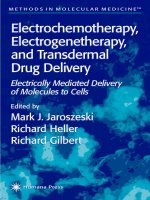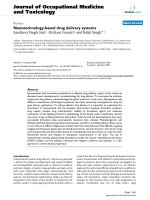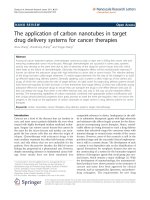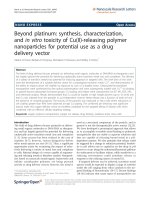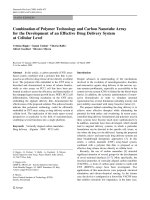Polymeric drugs and drug delivery systems 2001 ottenbrite
Bạn đang xem bản rút gọn của tài liệu. Xem và tải ngay bản đầy đủ của tài liệu tại đây (8.73 MB, 313 trang )
©2001 CRC Press LLC
TOC_Tech_Poly_183160
10/24/2000
10:13 AM
Page v
Table of Contents
Preface
1. SEMITELECHELIC POLY[N-(2-HYDROXYPROPYL)METHACRYLAMIDE] FOR BIOMEDICAL APPLICATIONS
ˇ
ˇ
ZHENG-RONG LU, PAVLA KOPECKOVÁ,
and JINDRICH KOPECEK
Introduction
Synthesis of Semitelechelic HPMA Polymers
Characterization of Semitelechelic HPMA Polymers
Modification of Proteins with Semitelechelic HPMA Polymers
Modification of Biomedical Surfaces with Semitelechelic
HPMA Polymers
Conjugation with Hydrophobic Anticancer Drugs
Conclusions
References
2. THERMORESPONSIVE POLYMERIC MICELLES
FOR DOUBLE TARGETED DRUG DELIVERY
J. E. CHUNG and TERUO OKANO
Introduction
Preparation of Thermoresponsive Polymeric Micelles
(Scheme 3)
On–Off Switchable Drug Release from Thermoresponsive
Polymeric Micelles
©2001 CRC Press LLC
TOC_Tech_Poly_183160
10/24/2000
10:13 AM
Page vi
Cytotoxicity of Polymeric Micelles Modulated by
Temperature Changes
References
3. pH/TEMPERATURE-SENSITIVE POLYMERS
FOR CONTROLLED DRUG DELIVERY
SOON HONG YUK, SUN HANG CHO, SANG HOON LEE,
JUNG KI SEO, and JIN HO LEE
Introduction
Experimental Section
Results and Discussion
Conclusions
References
4. DESIGN OF POLYMERIC SYSTEMS FOR TARGETED
ADMINISTRATION OF PEPTIDE AND PROTEIN DRUGS
EMO CHIELLINI, ELISABETTA E. CHIELLINI, FEDERICA CHIELLINI,
and ROBERTO SOLARO
Introduction
Experimental
Results and Discussion
Conclusions
References
5. DRUG RELEASE FROM IONIC DRUGS
FROM WATER-INSOLUBLE DRUG-POLYION
COMPLEX TABLETS
NANDINI KONAR and CHERNG-JU KIM
Introduction
Experimental
Results and Discussion
Conclusions
References
6. POLYCHELATING AMPHIPHILIC POLYMERS (PAP)
AS KEY COMPONENTS OF MICROPARTICULATE
DIAGNOSTIC AGENTS
VLADIMIR P. TORCHILIN
Imaging Principles and Modalities
Loading of Liposomes and Micelles with Contrast Agents
©2001 CRC Press LLC
TOC_Tech_Poly_183160
10/24/2000
10:13 AM
Page vii
Diagnostic Liposomes and Micelles with PAPs
Experimental Visualization with PAP-Containing
Microparticular Contrast Agents
References
7. BIOCONJUGATION OF BIODEGRADABLE POLY
(LACTIC/GLYCOLIC ACID) TO PROTEIN, PEPTIDE,
AND ANTI-CANCER DRUG: AN ALTERNATIVE
PATHWAY FOR ACHIEVING CONTROLLED RELEASE
FROM MICRO- AND NANOPARTICLES
TAE GWAN PARK
Introduction
Controlled Release from PLGA Microspheres
Conjugation of PLGA to Drugs
Conjugation of PLGA to Lysozyme
Conjugation of PLGA to an Amino Acid Derivative
Conjugation of PLGA to Doxorubicin
Conclusion
References
8. ELASTIN–MIMETIC PROTEIN NETWORKS
DERIVED FROM CHEMICALLY CROSSLINKED
SYNTHETIC POLYPEPTIDES
R. ANDREW MCMILLAN and VINCENT P. CONTICELLO
Introduction
Results and Discussion
Conclusions
References
9. GENETICALLY ENGINEERED PROTEIN DOMAINS
AS HYDROGEL CROSSLINKS
ˇ
CHUN WANG, RUSSELL J. STEWART, and JINDRICH KOPECEK
Introduction
Hydrogels as Biomaterials
Genetically Engineered Biomaterials
Coiled Coils
Designs of Hybrid Hydrogels
Conclusions and Future Perspectives
References
©2001 CRC Press LLC
TOC_Tech_Poly_183160
10/24/2000
10:13 AM
Page viii
10. SUPERPOROUS HYDROGEL COMPOSITES: A NEW
GENERATION OF HYDROGELS WITH FAST
SWELLING KINETICS, HIGH SWELLING RATIO
AND HIGH MECHANICAL STRENGTH
KINAM PARK, JUN CHEN, and HAESUN PARK
Introduction
Swelling Kinetics of Hydrogels
Hydrogels, Microporous Hydrogels,
and Macroporous Hydrogels
Superporous Hydrogels (SPHs)
Methods of Preparing Porous Hydrogels
Superporous Hydrogel Composites (SPHs)
Applications
Future of SPHs and SPH Composites
References
11. STRUCTURE AND SOLUTE SIZE EXCLUSION OF
POLY(METHACRYLIC ACID)/POLY(N-ISOPROPYL
ACRYLAMIDE) INTERPENETRATING POLYMERIC
NETWORKS
JING ZHANG and NICHOLAS A. PEPPAS
Introduction
Experimental
Results and Discussion
Conclusion
References
12. THERMODYNAMICS OF WATER SORPTION
IN HYALURONIC ACID AND ITS DERIVATIVES
P. A. NETTI, L. AMBROSIO, and L. NICOLAIS
Introduction
Materials
Results
Discussion
Conclusions
References
13. PHOTOCROSSLINKED POLYANHYDRIDES WITH
CONTROLLED HYDROLYTIC DEGRADATION
AMY K. BURKOTH and KRISTI S. ANSETH
Introduction
Experimental
Results
©2001 CRC Press LLC
TOC_Tech_Poly_183160
10/24/2000
10:13 AM
Page ix
Conclusions
References
14. NOVEL CYTOKINE-INDUCING MACROMOLECULAR
GLYCOLIPIDS FROM GRAM-POSITIVE BACTERIA
MASAHITO HASHIMOTO, YASUO SUDA, YOSHIMASA IMAMURA,
JUN-ICHI YASUOKA, KAZUE AOYAMA, TOSHIHIDE TAMURA,
SHOZO KOTANI, and SHOICHI KUSUMOTO
Introduction
Material and Methods
Results and Discussion
References
15. HYDROPHOBE MODIFIED CATIONIC
POLYSACCHARIDES FOR TOPICAL
MICROBICIDE DELIVERY
GEORGE L. BRODE, GUSTAVO F. DONCEL, and JOHN E. KEMNITZER
Introduction
Rationale for Design
Chemistry of Vehicles
DCE Vehicle Characterization
Anti-Viral Design Parameters
Contraceptive Design Parameters
Vehicle Bioadhesion
Summary
Future Considerations
References
16. NOVEL ANTIMICROBIAL N-HALAMINE
POLYMER COATINGS
S. D. WORLEY, M. EKNOIAN, J. BICKERT, and J. F. WILLIAMS
Introduction
Experimental
Results and Discussion
Conclusion
References
17. DESIGN OF MACROMOLECULAR PRODRUG
OF CISPLATIN ATTACHED TO DEXTRAN
THROUGH COORDINATE BOND
TATSURO OUCHI, MITSUO MATSUMOTO, TATSUNORI MASUNAGA,
YICHI OHYA, KATSUROU ICHINOSE, MIKIROU NAKASHIMA,
MASATAKA ICHIKAWA, and TAKASHI KANEMATSU
©2001 CRC Press LLC
TOC_Tech_Poly_183160
10/24/2000
10:13 AM
Page x
Introduction
Experimental
Results and Discussion
References
18. SYNTHESIS OF LINEAR AND HYPERBRANCHED
STEREOREGULAR AMINOPOLYSACCHARIDES
BY OXAZOLINE GLYCOSYLATION
JUN-ICHI KADOKAWA, HIDEYUKI TAGAYA, and KOJI CHIBA
Introduction
Experimental
Results and Discussion
Conclusions
References
19. DIAMETER AND DIAMETER DISTRIBUTIONS
OF POLY(L-LACTIDE) MICROSPHERES BY
RING-OPENING POLYMERIZATION OF L-LACTIDE
AND FROM EARLIER SYNTHESIZED POLYMERS
STANLEY SLOMKOWSKI and STANLEY SOSNOWSKI
Introduction
Experimental Part
Results and Discussion
Conclusions
References
20. EXAMINATION OF FLUORESCENT MOLECULES AS
IN SITU PROBES OF POLYMERIZATION REACTIONS
FRANCIS W. WANG and DEBORAH G. SAUDER
Introduction
Experimental
Results
Conclusions
References
21. SELF-ETCHING, POLYMERIZATION-INITIATING
PRIMERS FOR DENTAL ADHESION
CHETAN A. KHATRI, JOSEPH M. ANTONUCCI,
and GARY E. SCHUMACHER
Introduction
Experimental
©2001 CRC Press LLC
TOC_Tech_Poly_183160
10/24/2000
10:13 AM
Page xi
Results and Discussion
References
22. BIOACTIVE POLYMERIC COMPOSITES BASED ON
HYBRID AMORPHOUS CALCIUM PHOSPHATES
JOSEPH M. ANTONUCCI, DRAGO SKRTIC,
ARTHUR W. HAILER, and EDWARD D. EANES
Introduction
Experimental
Results and Discussion
Conclusion
References
©2001 CRC Press LLC
FM_Tech_Poly_183160
10/24/2000
10:11 AM
Page xiii
Preface
O
the last quarter century we have seen the field of biorelated polymers for medical applications undergo a dramatic transition from the
pragmatic and/or serendipic approach to applying basic research principles.
Specifically, we have seen the development of many new polymeric materials for intended applications and solutions to problems related to those applications. The development during this time has been dynamic with the
consistent emergence of new findings. Consequently, one can anticipate a
literal explosion of new clinical products and applications that will be derived from this multidisciplinary field in the next millenium.
The basis of this book is to expose the reader to the important areas of synthetic biorelated polymers systems and the potential impact they will have in
the 21st Century. Consequently, we deliberated over the appropriate areas to
be covered in this book, what value these would provide, and who could
benefit. The chapters are written to emphasize the chemical and physical
properties of several unique polymer systems and the many stages involved
in their physiological adaptations to achieve an intended utilization. The importance of multidisciplinary knowledge and skills are unprecedented since
the field encompasses chemistry, materials science, engineering, biochemistry, biophysics, pharmacology, physiology, and clinical studies.
There are 22 chapters in the book and they cover the most important
aspects of polymers as drugs, prodrugs, drug delivery systems, and in situ
prostheses. The major features promulgated are synthesis, derivatization,
degradation, characterization, application, and evaluation techniques as
well as new biodegradable materials, assemblies, hydrogels, telechelic
polymers, derivatized polysaccharides, micro- and nanoparticles, mimetic
VER
©2001 CRC Press LLC
FM_Tech_Poly_183160
10/24/2000
10:11 AM
Page xiv
protein networks, and interpenetrating polymers. Polymer drug design for
enhanced physiological drug distribution, drug targeting, time-controlled
release, and sensor-responsive release are also presented. In addition,
accounts are given on in situ probes, microparticle diagnostic agents, and
sensor devises.
We wish to thank the contributors to this publication who are outstanding representatives of the multidisciplinary sciences necessary to so fruitfully accomplish the work that has been so elegantly described.
©2001 CRC Press LLC
01CH_Tech_Poly_183160
10/24/2000
7:28 AM
Page 1
CHAPTER 1
Semitelechelic Poly[N-(2-hydroxypropyl)methacrylamide] for Biomedical
Applications
ZHENG-RONG LU1
PAVLA KOPECˇKOVÁ1
JINDRICH KOPECˇEK1
INTRODUCTION
EMITELECHELIC (ST) polymers are low molecular weight (Mn Ͻ 20,000)
S
linear macromolecules having a reactive functional group at one end of
the polymer chain and one terminal end. The single functional group is able to
conjugate or graft the macromolecules to other molecular species or surfaces.
The modification of therapeutic proteins or biomedical surfaces with the synthetic polymers improves their properties. For example, the covalent attachment of macromolecules to therapeutic proteins results in an increase of their
resistance to proteolysis, reduction of their antigenicity, and prolongation of
intravascular half-life [1–3]. The modification of enzymes with synthetic
polymers permits their use as catalysts of organic reactions in organic solvents due to increased stability [4,5]. Modification of biomedical surfaces
may reduce their biorecognizability and/or prevent protein adsorption [6,7].
Due to the multifunctionality of proteins or surfaces, the polymers containing
multifunctional groups may lead to cross-linking or loop formation; semitelechelic polymers seem to be the macromolecules of choice. The ST polymers permit one point attachment and avoid the cross-linking of the substrates caused by multipoint attachment. The water-soluble ST polymers can
also be conjugated to hydrophobic anticancer drugs to form more soluble,
more easily formulated, and deliverable drugs [8].
1Departments of Pharmaceutics and Pharmaceutical Chemistry/CCCD, and of
Bioengineering, University of Utah, Salt Lake City, UT, 84112, USA.
©2001 CRC Press LLC
01CH_Tech_Poly_183160
10/24/2000
7:28 AM
Page 2
Methoxy poly(ethyleneglycol) (mPEG) was the most frequently used
semitelechelic polymer for over 2 decades. It has been successfully used for
the modification of various proteins, biomedical surfaces and hydrophobic
anticancer drugs (for reviews see References [3,9,10]. Recently, a number
of new semitelechelic (ST) polymers, such as ST-poly(N-isopropylacrylamide) (ST-PNIPAAM) [11–15], ST-poly(4-acryloylmorpholine) (STPAcM) [16], ST-poly(N-vinylpyrrolidone) (ST-PVP) [17], and ST-poly[N(2-hydroxypropyl)methacrylamide] (ST-PHPMA) [18–21] have been
prepared and shown to be effective in the modification of proteins or biomedical surfaces.
HPMA copolymers are water-soluble biocompatible polymers, widely
used in anticancer drug delivery (reviewed in Reference [22]). HPMA
copolymers containing reactive groups at side-chain termini were previously used for the modification of trypsin [23], chymotrypsin [23,24], and
acetylcholinesterase [25]. The modification dramatically increased the
acetylcholinesterase survival in the blood stream of mice and the thermostability of modified enzymes when compared to the native proteins. However,
the modification involved multipoint attachment of the copolymers to the
substrates, which may cause crosslinking. To modify proteins or biomedical
surfaces by one point attachment, semitelechelic polymers should be used.
SYNTHESIS OF SEMITELECHELIC HPMA POLYMERS
Semitelechelic HPMA polymers were synthesized by free radical polymerization of HPMA using 2,2Ј-azobis(isobutyronitrile) (AIBN) as the initiator and alkyl mercaptans as chain transfer agents. Alkyl mercaptans with
different functional groups, namely, 2-mercaptoethylamine, 3-mercaptopropionic acid, 3-mercaptopropionic hydrazide, and methyl 3-mercaptopropionate, were used as the chain transfer agents; ST HPMA polymers
©2001 CRC Press LLC
01CH_Tech_Poly_183160
10/24/2000
7:28 AM
Page 3
Scheme 1 Synthesis of ST-PHPMA polymers [20].
with amino, carboxy, hydrazo, and methyl ester end groups, respectively,
were prepared (Scheme 1) [20]. The functional end groups of the ST HPMA
polymers can be transformed to other active functional groups. For example,
ST-PHPMA-COOCH3 was transformed to ST-PHPMA-CONHNH2 by the
reaction with an excess of hydrazine [20]. Semitelechelic polymers with
N-hydroxysuccinimide (HOSu) ester end groups ST-PHPMA-COOSu were
synthesized by esterification of ST-PHPMA-COOH with a large excess of
N-hydroxysuccinimide with dicyclohexyl carbodiimide (DCC) as coupling
agent. The ST-PHPMA-COOSu will react with amino groups on proteins
and on biomedical surfaces. The molecular weight of the ST-PHPMA after
polymer analogous esterification did not change, confirming the assumption
that the secondary OH groups of the HPMA monomer were not reactive
under the experimental conditions used [20].
The free radical polymerization of HPMA in the presence of mercaptans
involves two different initiation mechanisms (Scheme 2) [26]. One is the
initiation by RS• radicals from chain transfer agent; the other appears to be
the direct initiation by the primary isobutyronitrile (IBN) radicals formed by
the decomposition of AIBN [27]. The RS• are formed by either the free radical transfer reaction of alkyl mercaptans with the IBN radicals or the chain
transfer reaction of an active polymer chain with the mercaptans. The initiation by the RS• radicals produces the ST polymers with a functional group at
one end of the polymer chain. The initiation by IBN radicals leads to nonfunctional polymer chains with an IBN end group. The presence of the polymers with IBN end groups effects the purity and the functionality of ST
polymers. As expected, the production of nonfunctionalized polymer chains
is affected by reaction conditions. The polymerization is mainly terminated
by chain transfer reaction with the mercaptans, but other termination mechanisms, such as disproportionation and recombination, take place depending on the reaction conditions [26].
©2001 CRC Press LLC
01CH_Tech_Poly_183160
10/24/2000
7:28 AM
Page 4
Scheme 2 The mechanism of the chain transfer free radical polymerization of HPMA in the presence of alkyl mercaptans [26].
The concentrations of both chain transfer agent and initiator are important
for the polymerization when the concentration of HPMA is constant. The
molecular weight of the ST HPMA polymers was regulated by the concentration ratio of mercaptan (S) to HPMA (M), according to the Mayo equation, 1DPn(end) ϭ 1/DPn,o ϩ Cs[S]/[M] [27]. DPn(end) and DPn,o are the number average degrees of the polymerization in the presence and in the absence
of the chain transfer agents S; Cs is the chain transfer constant; Cs ϭ ku/kp,
where ku is the rate constant for chain transfer and kp is the rate constant for
propagation. Figure 1 shows the dependence of the molecular weight of the
ST PHPMA polymers on the concentration ratio of mercaptans to HPMA.
High [S]/[M] produces ST HPMA polymers with low molecular weight and
higher purity, and vice versa. The concentration ratio of AIBN to HPMA
does not have a significant effect on the chain length of the polymers in the
presence of chain transfer agents but has an impact on the purity of the ST
HPMA polymers. A low [AIBN]/[HPMA] ratio produces ST HPMA polymers with high purity, i.e., a smaller content of polymers with IBN end
©2001 CRC Press LLC
01CH_Tech_Poly_183160
10/24/2000
7:28 AM
Page 5
Figure 1 The effect of concentration ratio of mercaptans (, 2-mercaptoethylamine; ࡗ, methyl
3-mercaptopropionate; ᭡, 3-mercaptopropionic acid; ᭹, 3-mercaptopropionic hydrazide) to
HPMA on the weight average molecular weight (SEC) of ST HPMA polymers (data from Reference [20]).
groups, and a narrower molecular weight distribution [26]. The dependence
of the relative content of nonfunctional macromolecules on the concentrations of both mercaptan and initiator suggested that there might be a competition between the initiation by IBN radicals and the free radical transfer reaction of the radicals with mercaptans.
The efficiency of the alkyl mercaptans also has an influence on the chain
transfer polymerization. The chain transfer constants of 2-mercaptoethylamine, 3-mercaptopropionic acid, methyl 3-mercaptopropionate, and 3mercaptopropionic hydrazide are 0.08, 0.34, 0.38, and 0.8, respectively
[20]. This is reflected in the molecular weights obtained, the lower the CS
the higher the molecular weight of the ST-PHPMA at a constant
[S]/[HPMA] ratio. 2-Mercaptoethylamine produced higher molecular
weight polymers at the same [S]/[HPMA] ratio compared with the other
mercaptans (Figure 1). The efficiency of chain transfer agent also affects
the production of polymer chains with IBN end groups. At identical
[S]/[HPMA] ratios, the most efficient chain transfer agent, 3-mercaptopropionic hydrazide, produces fewer polymer chains with IBN end groups
compared to the other mercaptans [19].
By analysis of the ST HPMA polymers by MALDI-TOF MS in the (more
sensitive) refectron mode it was possible to recognize macromolecules with
©2001 CRC Press LLC
01CH_Tech_Poly_183160
10/24/2000
7:28 AM
Page 6
small mass differences formed by different termination mechanisms. For
example, ST HPMA polymer chains with a mass difference of 2 Da, formed
by disproportionation termination were observed in the mass spectra. As
expected, the polymerization was mainly terminated by chain transfer reaction, and only a very small amount of active polymer chains terminated by
disproportionation. The polymerization can be terminated by recombination when the concentration of mercaptan was very low; in fact, macromolecules terminated by recombination were found in the MALDI-TOF mass
spectrum of a ST-polymer produced at a very low molar ratio of mercaptan
to HPMA [26].
Because some of the macromolecules were initiated by the primary radicals to form macromolecules with initiator end groups, the functionality
of ST HPMA polymers could be improved by using an initiator containing
the same functional group as the chain transfer agent.
CHARACTERIZATION OF SEMITELECHELIC HPMA POLYMERS
Several different methods were used to characterize the ST HPMA polymers. The average molecular weights of the ST polymers were determined
by size exclusion chromatography (SEC). The functional end groups of ST
HPMA polymers were determined by different chemical assays based on
the properties of the end groups. The amino groups in ST-PHPMA-NH2
were determined by ninhydrin and trinitrobenzene sulfonic acid (TNBS)
assays. The carboxyl groups of ST-PHPMA-COOH were determined by
titration. The methyl ester groups in ST-PHPMA-COOCH3 were determined by proton NMR and by hydrolysis with excess KOH followed by
titration of the remaining KOH with HCl. The hydrazo end groups in STPHPMA-COONHNH2 were determined by the TNBS assay [20].
The polymers were also characterized by MALDI-TOF MS [28]. This
new technique can accurately determine the molecular weight of a protein
and a polymer chain and provide important information on the structure of
repeating units and end-group compositions of synthetic polymers [29,30].
In contrast, the conventional SEC can only provide the molecular weight
distribution; in addition, calibration standards with similar structures are
required for the calculation of the average molecular weights. Currently,
mass spectrometry is able to measure the mass of a macromolecule up to
106 Da. For synthetic polymers, however, the new technique could not provide accurate molecular weight distribution data for the polymers with a
broad polydispersity (PD). The method underestimated peaks corresponding to higher masses, resulting in lower values of the average molecular
weights compared with SEC. Consequently, the average molecular weights
of the ST HPMA polymers (PD Ͼ 1.1) calculated from the mass spectra
©2001 CRC Press LLC
01CH_Tech_Poly_183160
10/24/2000
7:28 AM
Page 7
were lower than those determined by SEC. However, the average molecular weights determined by MALDI-TOF MS for the narrow dispersed
polymers showed good agreement with those obtained by SEC. For example, there was a good agreement between the average molecular weights of
fractionated ST-PHPMA (PD Ͻ 1.1) determined by the MALDI-TOF MS
and the SEC, respectively. The average molecular weights of ST-PHPMA
fractions (PD Ͻ 1.1) obtained from the MS were only slightly lower than
those from SEC, and the difference between two methods was less than 7%
[20]. The mass spectrometry is a fast, precise method to determine the molecular weight of protein–polymer conjugates; it is difficult to obtain suitable standards for the calibration of SEC to characterize such conjugates.
Although the MALDI-TOF MS has a limitation to determine the average molecular weight of synthetic polymers with high polydispersity, the
accurate determination of the molecular weight of individual macromolecules provides important information on the chemical structure of the end
groups and the composition of individual polymer chains of semitelechelic
polymers. Shown in Figure 2 is a MALDI-TOF mass spectrum of a STPHPMA with COOCH3 end groups. Two main peak series corresponding
to macromolecules with different end groups in the polymer sample can be
identified. The mass increment between peaks with identical end groups
was 143.2, the mass of a HPMA monomer unit. Peak series a) at m/z ϭ
n ϫ 143.2 ϩ 23(Naϩ) ϩ 68.1 ϩ 1.0 [n is the number of monomer units;
Figure 2 MALDI-TOF mass spectrum of a ST-PHPMA-COOCH3. Peak series a represent polymer chains with initiator (IBN) end groups; peak series b represent polymer chains with methyl
ester end groups.
©2001 CRC Press LLC
01CH_Tech_Poly_183160
10/24/2000
7:28 AM
Page 8
mass of the initiator residue (CH3)2[CN]C (IBN) is 68.1] corresponds to
polymer chains initiated by IBN radicals and terminated by proton transfer
from methyl 3-mercaptopropionate (MMP). The peak series b) at m/z ϭ
n ϫ 143.2 ϩ 23(Naϩ) ϩ 120.2 (molar mass of methyl mercaptopropionate
ϭ 120.2 Da) represents the semitelechelic polymer chains H-(HPMA)nSCH2CH2COOCH3 initiated by the radical formed from MMP (RЈS•) and
terminated by proton transfer from MMP. The MALDI-TOF mass spectra
of ST HPMA polymers clearly showed the presence of polymer chains
formed by the direct initiation with primary IBN radicals. Consequently,
the polymer chains with IBN end groups were found in the mass spectra of
almost all the ST HPMA polymers. As discussed above, the relative peak
intensity (reflecting the relative content) of the polymer chains with IBN
end groups in the mass spectra of the ST HPMA polymers varied with the
reaction conditions and the chain transfer constant of particular mercaptan.
MODIFICATION OF PROTEINS WITH SEMITELECHELIC
HPMA POLYMERS
The modification of therapeutic proteins with synthetic polymers is one
of the methods to enhance their pharmacological activity. Synthetic polymers can be conjugated to proteins by reacting the active functional groups
of the polymers with the functional groups of the protein, such as amino,
carboxyl, hydroxyl, and sulfhydryl groups. The most frequently used
method is the modification of the amino groups of the proteins containing
synthetic polymers with active ester groups. There are also reports on the
modification of the hydroxyl [10] and sulfhydryl [31] groups of the proteins.
Carboxyl group modification is not frequently used [10,32], although the
carboxyl group is a common group in proteins. Here, we focus the discussion on the modification of the amino and carboxyl groups of the proteins.
␣-Chymotrypsin (CT) was used as the model protein to evaluate the consequences of its modification with the ST HPMA polymers. There are 17
carboxyl groups and 17 amino groups in ␣-chymotrypsin. The amino and
carboxyl groups of the protein were modified with ST-PHPMA-COOSu and
ST-PHPMA-CONHNH2, respectively. The amino-directed modification of
CT was performed by directly reacting the protein with excess ST-PHPMACOOSu at neutral pH (7.0–7.5) and 4°C in 20 mM in CaCl2 aqueous solution. The carboxyl group-directed modification with polymers containing
hydrazo was performed by reacting the protein with an excess of STPHPMA-CONHNH2 at pH 4.5–5.0 in the presence of 1-ethyl-3-(3-dimethylaminopropyl)carbodiimide hydrochloride (EDC). At the acidic pH
used, the amino groups (pKa ϭ 6.8–8.0 for ␣-amino, 10.4–11.1 for ⑀-amino
of lysine) on proteins are deactivated due to protonation. However, the hy©2001 CRC Press LLC
01CH_Tech_Poly_183160
10/24/2000
7:28 AM
Page 9
drazo groups (pKa Ϸ 3.0) remain active to react with the carboxyl groups of
the same proteins in the presence of a coupling agent (EDC). The pH of the
reaction mixture during both modifications may change, and dilute NaOH
or HCl should be added to maintain suitable pH [20].
The conjugates were characterized by MALDI-TOF mass spectrometry,
and the mass spectrum of a carboxyl-modified CT conjugate is shown as
an example (Figure 3). The mass spectrum showed a broad peak for the
conjugate because of the random conjugation of different molecular
weight macromolecules to the enzyme. Nevertheless, the molecular
weights of the conjugates can be calculated from the molecular weight distribution in the corresponding mass spectrum. The modification of CT with
narrow fractions of ST HPMA polymers produced conjugates possessing a
uniform structure compared with those prepared from unfractionated semitelechelic macromolecules [20].
The conjugation degree or the number of polymer chains on each protein
molecule depends on the molecular weight of the polymers and on the conjugation conditions. Lower molecular weight polymers produced conjugates with a higher conjugation degree. This is probably due to a smaller
hydrodynamic volume resulting in a lower steric exclusion effect. A higher
concentration ratio of ST-PHPMA to CT gave conjugates with a higher
conjugation degree when same molecular weight polymers were used for
the conjugation. When the polymer enzyme molar ratio was low in the carboxyl-directed modification, a much larger excess of coupling agent was
necessary to achieve a relatively high conjugation degree [20].
Figure 3 The MALDI-TOF mass spectrum of the chymotrypsin conjugate with a ST-PHPMANHNH2 fraction (Mw ϭ 1,400). The peaks 1, 2, and 3 are the double-charged, single-charged conjugate, and single-charged double conjugate aggregate, respectively.
©2001 CRC Press LLC
01CH_Tech_Poly_183160
10/24/2000
7:28 AM
Page 10
It seems that a maximum of about 10 ST-PHPMA chains can be attached
to 1 CT molecule. The conjugation degree was lower than that of the chymotrypsin conjugates with PEG-SC (succinimidyl carbonate of mPEG; up
to 14 chains per one CT molecule) [20,33]. This might be attributed to the
solution structure difference between the two polymers. PHPMA has a random coil structure in aqueous solution, whereas PEG possesses a more extended one. The coiled PHPMA may cover more of the enzyme surface, and
the steric effect may prevent more PHPMA macromolecules from attaching
to the enzyme.
The chemistry of the modification was important for the biological activity of the protein–polymer conjugate. Listed in Table 1 are the MichealisMenten kinetic constants of the enzymatically catalyzed cleavage of Z-GlyLeu-Phe-NAp (Z, benzyloxycarbonyl; NAp, p-nitroanilide) by the CT
conjugates and the native enzyme. The carboxyl group modified conjugates
I and II showed a lower activity than native CT [20]. The amino group modified conjugates III, IV, V, and VI showed higher reactivities than native CT,
similarly to literature data [21,32]. This indicates that the modification mode
of the protein affects the activity of the conjugates. Similar results have been
also reported by other research groups. Sakane and Pardridge [33] have
shown that carboxyl-directed pegylation of brain-derived neurotrophic factor preserved the biological activity of the conjugate, whereas the amino
group-directed modification did not. Pettit et al. [34] have shown that amino
group-directed pegylation of interleukin-15 alters the biological activity of
the conjugate. How the modifcation mode affects the biological activity of
the conjugates is not clear; nevertheless, modification of proteins with synthetic polymers definitely alters the conformation of the protein, and the
TABLE
Conjugate
Native
Chymotrypsin
I
II
III
IV
V
VI
1. Enzymatic Activity of the ST HPMA Polymer Modified
Chymotrypsin in the Cleavage of Z-Gly-Leu-Phe-NAp.
Bond
Modea
Conjugate
Mnb
Conjugate
Mwb
Npc
kcat/
KM(MϪ1SϪ1)
2,140
P-NHNHCO-E
P-NHNHCO-E
P-CONH-E
P-CONH-E
P-CONH-E
P-CONH-E
a
32,300
46,600
40,900
44,900
49,400
36,100
32,500
47,800
41,700
46,600
51,000
37,800
3
8
6 (5.8)
3.6 (3.7)
6.5 (7.3)
4.3 (4.3)
1,070
1,100
4,200
4,400
4,200
4,000
P represents polymer, and E the enzyme.
Determined by MALDI-TOF MS.
c
The number of polymer chains attached to each enzyme molecule; the data in the parentheses were obtained from TNBS assay (data from Reference [20]).
b
©2001 CRC Press LLC
01CH_Tech_Poly_183160
10/24/2000
7:28 AM
Page 11
charge character of protein may be also changed due to the modification. In
the case of CT, it is known that a carboxyl group of an aspartic acid is involved in the active site of chymotrypsin [35]. The conjugation of some of
the carboxyl groups might be the cause for the decrease in the activity of the
carboxyl group-modified chymotrypsin conjugates. It appears that the conjugation degree and the molecular weight of the polymers did not have a pronounced effect on the activity of chymotrypsin-ST HPMA conjugates toward Z-Gly-Leu-Phe-NAp.
For high molecular weight substrates, for example, PHPMA-Gly-LeuPhe-NAp, there was not much difference in the activity of both carboxyl
group modified conjugates and the amino group modified conjugates. The
activity of all the conjugates mentioned above exhibited lower activity than
CT. In this case, the steric hindrance of the polymer chains of the polymer
substrate and the conjugates dominates and makes the formation of enzyme
substrate more difficult, resulting lower activity of the conjugates [20].
MODIFICATION OF BIOMEDICAL SURFACES
WITH SEMITELECHELIC HPMA POLYMERS
Semitelechelic HPMA polymers also effectively modify biomedical surfaces. ST-PHPMA-NH2 of different molecular weights was used to modify
the surface of nanospheres based on a copolymer of methyl methacrylate,
maleic anhydride, and methacrylic acid [18]. The polymer chains were covalently attached to the surface; the efficiency of the polymer binding to
the surface and the thickness of the coating layer depended on the molecular weight of the polymers. High molecular weight polymers gave thicker
coatings but relatively low efficiency of binding. However, the thickness of
the ST PHPMA layer was less compared with commonly used PEG based
on the molecular weight. This was attributed to the fact that PEG has an extended conformation in water. However, the random coiled PHPMA chain
may cover more surface space similar to modified proteins; the occupied
area per PHPMA molecule is around 150 A2 [18].
The modification of biomedical surfaces with ST HPMA polymers decreased the biorecognizability of surfaces. The surface modification reduced
the protein adsorption to the nanospheres compared with the unmodified
nanospheres. The thickness of the coating layer and/or the molecular weight
of polymers also affected the protein adsorption; consequently, a thicker coating resulted in lower protein adsorption [18]. The protein repulsion of the
modified surface may be caused by the change of the surface energy [36] and
surface charge after the modification. The modified nanospheres had an increased intravascular half-life after intravenous administration to rats, and
the intravascular half-life increased with the increase of the molecular weight
©2001 CRC Press LLC
01CH_Tech_Poly_183160
10/24/2000
7:28 AM
Page 12
of ST PHPMA. The accumulation of the modified nanospheres in the liver decreased in a molecular weight–dependent manner. The higher the molecular
weight of the polymers, the lower the accumulation of the modified nanospheres in the liver. The molecular weight dependence of the biorecognition
seems to indicate the influence of the hydrodynamic thickness of the coating
layer on the process of opsonization and capture by Kupffer cells of the liver
and macrophages of the spleen [18].
The modification of the nanospheres with ST HPMA polymers significantly changed the surface structure and property of the nanospheres,
which resulted in substantial changes in the biorecognizability and biodistribution of the nanospheres. The biocompatibility of HPMA polymers
bodes well for the future application of ST PHPMA in the modification of
biomedical surfaces.
CONJUGATION WITH HYDROPHOBIC ANTICANCER DRUGS
HPMA copolymers are well-known carriers for anticancer drugs; two
HPMA copolymer-adriamycin conjugates are now in clinical trials [37].
The ST HPMA polymers are also promising in the modification of anticancer drugs. Usually, the anticancer drugs are hydrophobic organic compounds; their poor aqueous solubility diminishes their bioavailability and
therapeutic efficacy. Their conjugation to biocompatible water-soluble
polymers can increase their water solubility and thereby improve the therapeutic index. For example, taxol, a poorly soluble anticancer drug, has
been conjugated to one end of PEG via an ester bond to increase its water
solubility [8,39]. The ester bond between the polymer and the drug can be
hydrolyzed to release the drug in vivo. The water-soluble ST HPMA polymers can also be used for the conjugation of anticancer drugs via the functional end groups. The conjugation of anticancer drugs to ST HPMA polymer not only provides good solubility and a controlled drug release mode
but has the potential to overcome multidrug resistance [39]. Compared to
PEG, the ST HPMA polymers have the advantage that different functional
groups may be introduced to the polymers during the synthesis.
CONCLUSIONS
The functional semitelechelic HPMA polymers can be readily prepared
by free radical polymerization in the presence of functional mercaptans.
The functional groups and chain length of the ST polymers can be controlled by the choice of a particular mercaptan and the reaction conditions. ST HPMA polymers can be used for the modification of proteins
©2001 CRC Press LLC
01CH_Tech_Poly_183160
10/24/2000
7:28 AM
Page 13
and biomedical surfaces by one-point attachment. The activity of the
modified ␣-chymotrypsin was changed based on the chemistry of the
modification. The modification of the surface of nanospheres increased
their intravascular half-life in rats and reduced their biorecognizability.
REFERENCES
1. Abuchowski, A., Kazo, G. M., Verhoest, C. R., van Es, T., Kafkewitz, D., Nucci,
M. L., Viau, A. T., and Davis, F. F. Cancer Biochem. Biophys. 1984, 7, 175–186.
2. Gaertner, H. F., and Offord, R. E. Bioconjugate Chem. 1996, 7, 38–44.
3. Zalipsky, S. Bioconjugate Chem. 1995, 6, 150–165.
4. Takahashi, K., Ajima, A., Yoshimoto, T., Okada, M., Matsushima, A., Tamaura, Y.
and Inada, Y. J. Org. Chem. 1985, 50, 3412–3415.
5. Wang, P., Sergeeva, M. V., Lim, L. and Dordick, S. J. Nature Biotechnology 1997,
15, 789–793.
6. Gaertner, H. F. and Offord, R. E. Bioconjugate Chem. 1996, 7, 38–44.
7. Lee, J. H., Kopeˇcková, P., Kopecek, J., and Andrade, J. D. Biomaterials 1990, 11,
455–464.
8. Greenwald, R. B., Gilbert, C. W., Pendri, A., Conover, C. D., Xia, J., and Martinez,
A. J. Med. Chem. 1996, 39, 424–431.
9. Harris, J. M., Ed. Poly(ethylene glycol) Chemistry, Biotechnical and Biomedical
Applications, Plenum Press, New York, NY, 1992.
10. Harris J. M. and Zalipsky S., Eds. Poly(ethylene glycol) Chemistry and Biological
Applications, ACS, Washington, DC, 1997.
11. Gewehr, M., Nakamura, K., Ise, N., and Kitano, H. Makromol. Chem. 1992, 193,
249–256.
12. Takei, Y. G., Aoki, T., Sanui, K., Ogata, N., Okano, T., and Sakurai, Y. Bioconjugate Chem. 1993, 4, 42–46.
13. Takei, Y. G., Aoki, T., Sanui, K., Ogata, N., Sakurai, Y. and Okano, T. Biomaterials
1995, 16, 667–673.
14. Takei, Y. G., Matsukata, M., Aoki, T., Sanui, K., Ogata, N., Kikuchi, A., Sakurai,
Y., and Okano, T. Bioconjugate Chem. 1994, 5, 577–582.
15. Chen, G. and Hoffman, A. S., J. Biomater. Sci. Polymer Edn. 1994, 5, 371–382.
16. Ranucci, E., Spagnoli, G., Sartore, L. and Ferruti, P. Macromol. Chem. Phys. 1994,
195, 3469–3479.
17. Caliceti, P., Schiavon, O., Morpurgo, M. and Veronese, F. M., J. Bioact. Compat.
Polym. 1995, 10, 103–120.
18. Kamei, S. and Kopeˇcek, J. Pharmaceutical Res. 1995, 12, 663–668.
19. Lu, Z.-R., Kopeˇcková, P., Wu, Z., and Kopeˇcek, J. Polymer Preprints, 1998, 39(2),
218–219.
20. Lu, Z.-R., Kopeˇcková, P., Wu, Z., and Kopeˇcek, J. Bioconjugate Chem. 1998, 9,
793–804.
21. Ulbrich, K. and Oupick y´ , D. Eighth International Symposium on Recent Advances
in Drug Delivery Systems, 1997, pp. 215–218, Salt lake City, UT, February 24–27.
22. Putnam, D. and Kopeˇcek, J. Adv. Polym. Sci. 1995, 122, 55–123.
©2001 CRC Press LLC
01CH_Tech_Poly_183160
10/24/2000
7:28 AM
Page 14
23. Chytr y´ , V., Kopeˇcek, J., Sikk, P., Sinijärv, R., and Aaviksaar, A. Makromol. Chem.
Rapid Commun. 1982, 3, 11–15.
24. Kopeˇcek, J., Rejmanová, P., and Chytr y´, V. Makromol. Chem. 1981, 182, 799–809.
25. Lääne, A., Aaviksaar, A., Haga, M., Chytr y´ , V., and Kopeˇcek, J. Makromol. Chem.
Suppl. 1985, 9, 35–42.
26. Lu, Z.-R., Kopeˇcková, P., Wu, Z., and Kopeˇcek, J. submitted.
27. Heitz, W. In Telechelic Polymers: Synthesis and Applications; Goethals, E. J., Ed.;
CRC Press: Boca Raton, Florida; 1989, 61–94.
28. Russell, D. H. and Edmondson, R. D. J. Mass Spectrom. 1997, 32, 263–276.
29. Schadler, V., Spickermann, J., Rader, H. J., and Wiesner U. Macromolecules 1996,
29, 4865–4870.
30. Rader, H. J., Spickermann, J., and Mullen K. Macromol. Chem. Phys. 1995, 196,
3967–3978.
31. Chilkoti, A., Chen, G., Stayton, P. S., and Hoffman, A. S. Bioconjugate Chem.
1994, 5, 504–507.
32. Chiu, H. C., Zalipsky, S., Kopeˇcková, P., and Kopeˇcek, J. Bioconjugate Chem.
1993, 4, 290–295.
33. Sakane, T. and Pardridge, W. M. Pharmaceutical Res. 1997, 14, 1085–1091.
34. Pettit, D. K., Bonnert, T. P., Eisenman, J., Srinivasan, S., Paxton, R., Beers, C.,
Lynch, D., Miller, B., Grabstein, K. H., and Gombotz, W. J. Biol Chem. 1997, 272,
2312–2318.
35. Voet, D. and Voet J. G. Biochemistry (2nd ed.), John Wiley & Sons, New York,
1995, 371–410.
36. Gombotz, W. R., Guanghui, W., Horbett T. A. and Hoffman, A. S. In Poly(ethylene
glycol) Chemistry, Biotechnical and Biomedical Applications, Harris, J. M., Ed.
Plenum Press, New York, 1992, 247–261.
37. Cassidy, J., Vasey, P., Kaye, S. B. and Duncan, R. In Proceedings 2nd Int. Symp.
Polymer Therapeutics Kumamoto, Japan, 1997, 18.
38. Greenwald, R. B., Pendri, A., Bolikal, D. and Gilbert, C. W. Bioorg. Med. Chem.
Letters 1994, 4, 2465–2470.
39. Minko, T., Kopeˇckova, P., Pozharov, V. and Kopeˇcek J. J. Control. Release, 1998,
54, 223–233.
©2001 CRC Press LLC


